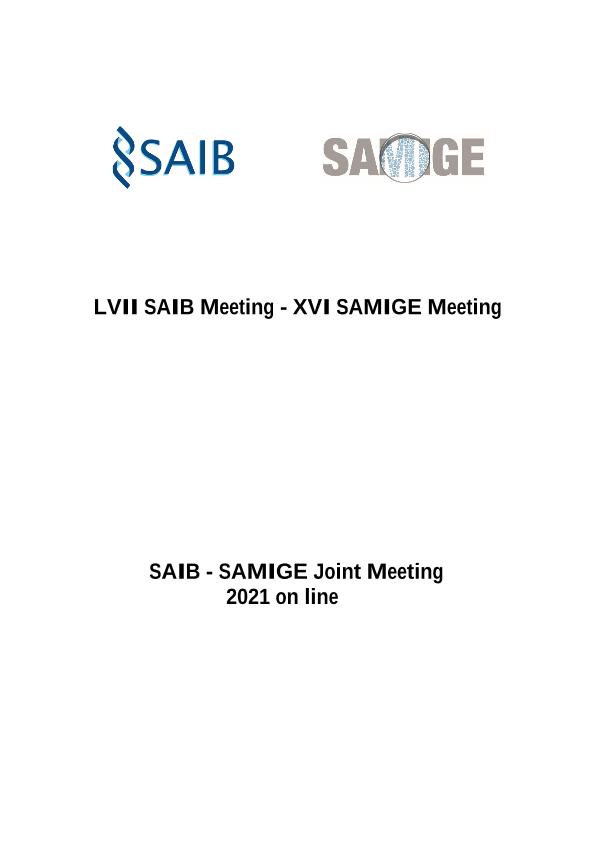Mostrar el registro sencillo del ítem
dc.contributor.author
Lax, Paola

dc.contributor.author
Becerra, Alejandra Gabriela

dc.date.available
2022-10-26T14:06:01Z
dc.date.issued
2021
dc.identifier.citation
Use of commercial fungal inoculants for the control of Nacobbus celatus; LVII Annual Meeting of the Argentine Society for Biochemistry and Molecular Biology Research; XVI Annual Meeting of the Argentinean Society for General Microbiology; Buenos Aires; Argentina; 2021; 96-96
dc.identifier.issn
0327-9545
dc.identifier.uri
http://hdl.handle.net/11336/174916
dc.description.abstract
Several species of plant-parasitic nematodes are responsible for causing considerable damage in agriculture. In Argentina, Nacobbus celatus (previously identified as N. aberrans) is widely distributed. It is a polyphagous species and produces galls on the host roots. In the last years, the search for biological control alternatives to replace chemical nematicides has increased, with emphasis on the use of rhizospheric organisms, including arbuscular mycorrhizal fungi (AMF) and Trichoderma spp. AMF establish a symbiotic association with 80% of terrestrial plants, conferring direct benefits, such as the absorption of nutrients (mainly phosphorus). On the other hand, AMF provide protection against soil pathogens, including plant-parasitic nematodes; the same antagonistic effect is also observed with Trichoderma spp. Commercial inocula of both microorganisms are available on the market, but their efficiency on local nematode populations is unknown. Considering a nematode population, an experiment was performed on tomato plants by applying two commercial inocula at the recommended doses: Rhizophagus intraradices (1 cc) and T. atroviride (dosis 2x106/ml). Treatments were: control, nematode, nematode + AMF, nematode + T. atroviride, nematode + AMF + T. atroviride. Inoculations were carried out at transplanting. Each treatment had five replicates; plants were grown under controlled conditions in a greenhouse for 60 days. After this time, the number of root galls induced by the nematode was counted. In comparison with the control, individual application of AMF and T. atroviride significantly reduced galls by 76% and 43%, respectively. The combined inoculation of the two fungi decreased the number of galls by 48%. The results show that the two commercial inocula have the potential to reduce N. celatus damage. Since the AMF-T. atroviride combination showed to be less efficient than the individual application of AMF, a possible antagonist effect of T. atroviride on AMF remains to be analysed.
dc.format
application/pdf
dc.language.iso
eng
dc.publisher
Tech Science Press

dc.rights
info:eu-repo/semantics/openAccess
dc.rights.uri
https://creativecommons.org/licenses/by-nc-sa/2.5/ar/
dc.subject
PLANT-PARASITIC NEMATODES
dc.subject
FUNGAL INOCULUM
dc.subject
NACOBBUS
dc.subject.classification
Otras Biotecnología Agropecuaria

dc.subject.classification
Biotecnología Agropecuaria

dc.subject.classification
CIENCIAS AGRÍCOLAS

dc.title
Use of commercial fungal inoculants for the control of Nacobbus celatus
dc.type
info:eu-repo/semantics/publishedVersion
dc.type
info:eu-repo/semantics/conferenceObject
dc.type
info:ar-repo/semantics/documento de conferencia
dc.date.updated
2022-06-03T18:34:42Z
dc.identifier.eissn
1667-5746
dc.journal.volume
46
dc.journal.number
1
dc.journal.pagination
96-96
dc.journal.pais
Argentina

dc.journal.ciudad
Buenos Aires
dc.description.fil
Fil: Lax, Paola. Consejo Nacional de Investigaciones Científicas y Técnicas. Centro Científico Tecnológico Conicet - Córdoba. Instituto de Diversidad y Ecología Animal. Universidad Nacional de Córdoba. Facultad de Ciencias Exactas Físicas y Naturales. Instituto de Diversidad y Ecología Animal; Argentina
dc.description.fil
Fil: Becerra, Alejandra Gabriela. Consejo Nacional de Investigaciones Científicas y Técnicas. Centro Científico Tecnológico Conicet - Córdoba. Instituto Multidisciplinario de Biología Vegetal. Universidad Nacional de Córdoba. Facultad de Ciencias Exactas Físicas y Naturales. Instituto Multidisciplinario de Biología Vegetal; Argentina
dc.relation.alternativeid
info:eu-repo/semantics/altIdentifier/url/https://congresos.g2consultora.com/wp-content/uploads/2021/10/Biocell-Preprint-SAIB-SAMIGE-2021.pdf
dc.conicet.rol
Autor

dc.coverage
Nacional
dc.type.subtype
Reunión
dc.description.nombreEvento
LVII Annual Meeting of the Argentine Society for Biochemistry and Molecular Biology Research; XVI Annual Meeting of the Argentinean Society for General Microbiology
dc.date.evento
2021-11-01
dc.description.ciudadEvento
Buenos Aires
dc.description.paisEvento
Argentina

dc.type.publicacion
Journal
dc.description.institucionOrganizadora
Argentine Society for Biochemistry and Molecular Biology Research
dc.description.institucionOrganizadora
Argentinean Society for General Microbiology
dc.source.libro
Biocell
dc.source.revista
Biocell

dc.date.eventoHasta
2021-11-05
dc.type
Reunión
Archivos asociados
